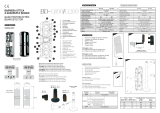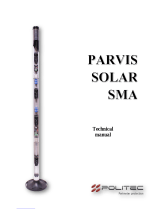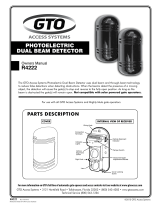
Qualora ostacoli (come alberi o panni appesi)
si frappongono tra trasmettitore e ricevitore.
In placements where obstacles (such as trees or even
full clothes-lines) are situated between the receiver
and the transmitter.
Qualora la barriera sia piantata in maniera
non stabile.
In places where the installation base is
unstable.
Qualora la barriera sia esposta ai raggi diretti
del sole o ai fari delle automobili.
In places where sunlight or car headlights shine
directly onto the detector.
Qualora si dovessero usare più barriere, per coprire lunghe distanze,
è opportuno evitare l’interferenza tra i fasci di luce.
In case of using many groups of detectors when long distance protection
to avoid the mutual disturbance of light beams.
50
75
100
125
150
175
200
250
1.5
2.3
3.0
3.8
4.5
5.4
6.0
7.5
Distanza di copertura (m) Dispersione (m)
Protection distance (m) Dispersion (m)
1. 50msec 3. 306msec 4. 408msec 5. 700msec2. 80msec
NO! NO!
INSTALLATION RECOMMENDATIONS
NOTE PER L’INSTALLAZIONE
DECLARATION OF CONFORMITY
DICHIARAZIONE DI CONFORMITÁ
ALIGNMENT
ALLINEAMENTO
via Fosso Antico, Centobuchi
63076 Monteprandone AP-Italy
tel +39 0735 705007
fax +39 0735 734912
info@inim.biz
www.inim.biz
DCMIINIEBDT-R120-20120328
ISO 9001: 2008 REGISTERED COMPANY
The declaration of conformity to the Directive 2004/108/CE may be consulted at
www.inim.biz/dc.html
La dichiarazione di conformità alla Direttiva 2004/108/CE può essere
consultata sul sito: www.inim.biz/dc.html
dampened with a small amount of alcohol.
creating motion in the protected area.
il malfunzionamento dei sensori stessi.
morbido con un pò di alcool.
sicurezza assoluta. Concordare con l’installatore le necessarie precauzioni.
Dopo l’installazione e il settaggio di tutti i parametri, è opportuno testare il
corretto funzionamento della barriera.
WARNINGATTENZIONE
NO!
Ricevitore
Trasmettitore
NO!
Ricevitore
Trasmettitore
Ricevitore
Trasmettitori
Ricevitore
Receiver
Transmitter
Receiver
Transmitter
Receiver
Transmitters
Receiver
Distanza di copertura
Protection distance
Dispersione
Dispersion
Altezza di montaggio
Mounting height
(0.7 - 1 m)
Left Right
Sinistra Destra
Ghiera per calibrazione orizzontale
Horizontal adjustment trimmer
Up Down
Su Giù
Vite per calibrazione verticale
Vertical adjustment screw
Un buon allineamento delle barriere è necessario ad ottimizzare la rivelazione dei sensori e
a prevenire falsi allarmi, specie in ambienti problematici.
Dopo il montaggio delle barriere, il loro allineamento si ottiene tramite la calibrazione della posizione delle lenti.
La calibrazione si effettua tramite la rotazione orizzontale o verticale dell’asse ottico rispetto la barriera:
Il livello dell’allineamento si può misurare in due modi:
1-8 si accendono a seconda dell’allineamento delle barriere;
più indicatori LED sono accesi, maggiore è l’allineamento tra sensori.
LEVEL.
Inserire i puntali di un tester facendo attenzione alla polarità indicata e misurare il voltaggio.
Un buon allineamento genera un voltaggio di almeno 1,5V (il massimo misurabile è 1,8V).
Accurate beam-alignment optimizes the sensing capacity of the detector and thus improves security
and lowers the false-alarm rate, especially in difficult environments.
After mounting the devices, correct alignment is achieved through the lens positions.
It is attained by rotating the optical axis horizontally or vertically:
The alignment level can be gauged in two ways:
1-8 light in accordance with the beam-alignment level;
the more LEDs that light, the better the beam alignment level.
A good level is indicated by the activation of 5 LEDs.
LEVEL connectors:
Insert the tester probes into the voltage-tester entries and measure the voltage.
A good level is indicated by a voltage of at least 1.5V (maximum measurable voltage is 1.8V).
RESPONSE TIME SETTING
CALIBRAZIONE DEL TEMPO DI RISPOSTA
trasmettitore, la barriera va in allarme.
Questi è calibrabile tramite la vite all’interno del foro segnalato con “RESPONSE TIME”,
su cui sono segnalati 5 livelli (vedi tabella).
If the receiver does not receive a signal from the transmitter within the set Response time, the detector will trigger an alarm.
The interval can be set by means of the screw inside the “RESPONSE TIME” entry. 5 settings are available (refer to table).
Angolo orizzontale (180°)
Horizontal direction (180°)
Angolo verticale (20°)
Vertical direction (20°)
1
2
3
4
5
50
80
306
408
700
Livello Tempo di risposta (msec)
Level Response time (msec)
TROUBLESHOOTING
The LEDs do not go ON
The alarm LED does not go ON
even when the beams are
violated.
other sources.
2. The three beams are not violated
simultaneously.
3. The response time is too short
1. Remove the reflecting object or
adjust the optical axis.
2. Increase the response time.
The alarm LED is always ON. 1. The optical axis is positioned incorrectly.
2. There are obstacles between the
transmitter and receiver.
3. The detector cover or lens is dirty.
1. Adjust the optical axis.
2. Remove the obstacle.
3. Clean the detector with a soft
lint-free cloth.
Intermittent alarm. 1. Improper wiring.
3. Moving obstacles between the transmitter
and receiver.
4. Unstable mounting base.
5. The optical axis is not well positioned.
6. The response time is too short.
7. The lenses do not emit beams.
3. Remove the obstacles.
4. Stabilize the base.
5. Adjust the optical axis.
6. Increase the response time.
7. Change the detector placements.
In the event of beam violation,
the alarm LED goes on but the
detector does not trigger an alarm.
1. There is a short circuit.
2. The terminal wiring has not been
completed correctly.
Trouble Possible cause Solution
SOLUZIONE DEI PROBLEMI
I LED non si accendono. Non è fornita un’adeguata tensione Controllare l’alimentazione o i cavi.
Il LED di allarme non si accende,
nemmeno in caso di blocco
dei raggi.
1. I raggi al ricevitore provengono da altre
sorgenti.
2. Non tutti dei 3 raggi sono bloccati.
3. Il tempo di risposta è troppo corto.
1. Rimuovere l’oggetto esterno che
produce raggi o modificare l’asse
ottico.
2. Aumentare il tempo di risposta.
Il LED di allarme è sempre
acceso
1. L’asse ottico non è ben direzionato.
2. Ci sono impedimenti tra il trasmettitore e
il ricevitore.
3. Il coperchio del sensore o le lenti sono
sporche.
1. Regolare l’asse ottico.
2. Rimuovere gli impedimenti.
3. Pulire con un panno soffice.
Allarme intermittente. 1. Cablaggio non buono.
2. La tensione fornita non è sufficiente.
3. Impedimenti mobili tra trasmettitore e
ricevitore.
4. La base di montaggio non è stabile.
5. Asse ottico non ben regolato.
6. Tempo di risposta troppo breve.
7. Mancata emissione dei raggi.
1. Controllare il cablaggio.
2. Controllare l’alimentazione.
3. Rimuovere gli impedimenti.
4. Cambiare posizione ai sensori.
5. Stabilizzare la base.
6. Calibrare l’asse ottico.
7. Calibrare il tempo di risposta.
In caso di blocco dei raggi,
il LED d’allarme si accende, ma
il sensore non va in allarme.
1. C’è un corto circuito nei collegamenti.
2. I collegamenti ai terminali non sono fatti a
regola.
Controllare il cablaggio e i terminali
Problema Possibile causa Soluzione







